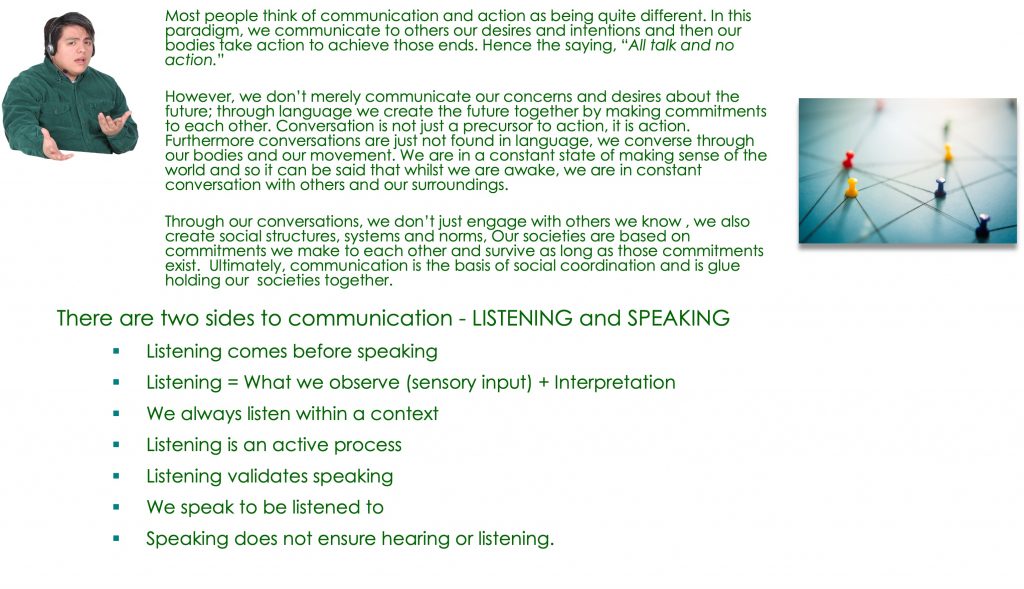
In his book, ‘The Good Listener’, Hugh Mackay termed this approach to communication the ‘injection myth’.
“The ‘injection myth’ treats messages rather like drugs which act on other people’s mind. It assumes that messages have inherent power (their ‘meaning’). In order to be effective communicators – the theory goes – we first have to craft our messages as carefully as we can, so as to maximise our ‘impact’ on the listener.
Having created our message, we now choose a medium for injecting it into the mind of the other person. The medium we choose is the equivalent of a hypo syringe or even a gun: we load our message – like a drug or a bullet – into the medium and then inject it via the eye or the ear – or preferably both. At that point, we’ve done all we can. The drugs, entering the mind of the other person, will now do its magic work. It will cause that person to think what we want them to think, to feel what we want them to feel or, of it’s a really powerful message, it might even get them to do what we want them to do.”
The basis of the ‘injection myth’ lies in a traditional definition of communication whereby language is descriptive and communication the transfer of information from one person to another. This notion of communication has been further propagated in the wake of technological advances where messages are sent from say a radio transmitter and received in a radio and then converted into sound. The premise is by sending the right signals you get the right result.
This is still the common view of communication and those involved in the so-called ‘communications industry’ seek to promulgate this perspective – “Buy a better smart phone and you will communicate better.” Whereas there is no denial that having a more effective communication technology has the potential to enhance communication, this view focuses on communication purely in terms of the medium.
The result of all this is most people associate good communication with good speaking whereby the skilful crafting our message will lead to effective communication with others. This approach sees listening as a passive part of the communication process. Speak well and the correct listening will automatically follow.
However this approach neglects some fundamental aspects of communication – distilling meaning, coordinating action and taking care of people’s concerns. As we are each a unique observer of the world then, accordingly, how we create meaning is unique to each of us. If there are fifty people listening to a presenter, they are subject to the same situation but there will be fifty different interpretations of what happened. Some of these views will be similar but some will not. None will be identical. These interpretations are not found in the presenter’s speaking but in each individual’s listening.
Listening is not a passive process but an active one. We create meaning through our listening and so it is primarily listening, not speaking, that defines what is communicated. As Rafael Echeverria says, “… we say what we say, and people listen to what they listen to; saying and listening are separate phenomena.” This is not to say that speaking is not an important part of communication, rather I want to emphasise the pivotal role of listening.
We speak to be listened to and our speaking is validated in the listening of others. This is a key aspect of determining our story of who we are – our self-story. We speak because we want to take care of some concern at that time and feel we can do so through our speaking. We speak from a basic assumption that others will listen to what we have to say and see something worthwhile in our speaking. Not being listened to by others has a direct impact on our core concerns and our dignity. If we notice a pattern of others not listening to us, we can develop a story they do not see any value in what we are offering through our speaking and translate this into a story they do not see any value in us.
The distinction of speaking and listening as separate phenomena is key to understanding how human beings communicate with each other, yet most people do not distinguish them as such when they communicate. We normally assume that what is said is exactly what is interpreted, yet this is not the case. This gap represents the major cause of communication breakdowns, yet is largely transparent to many people in their conversations.
